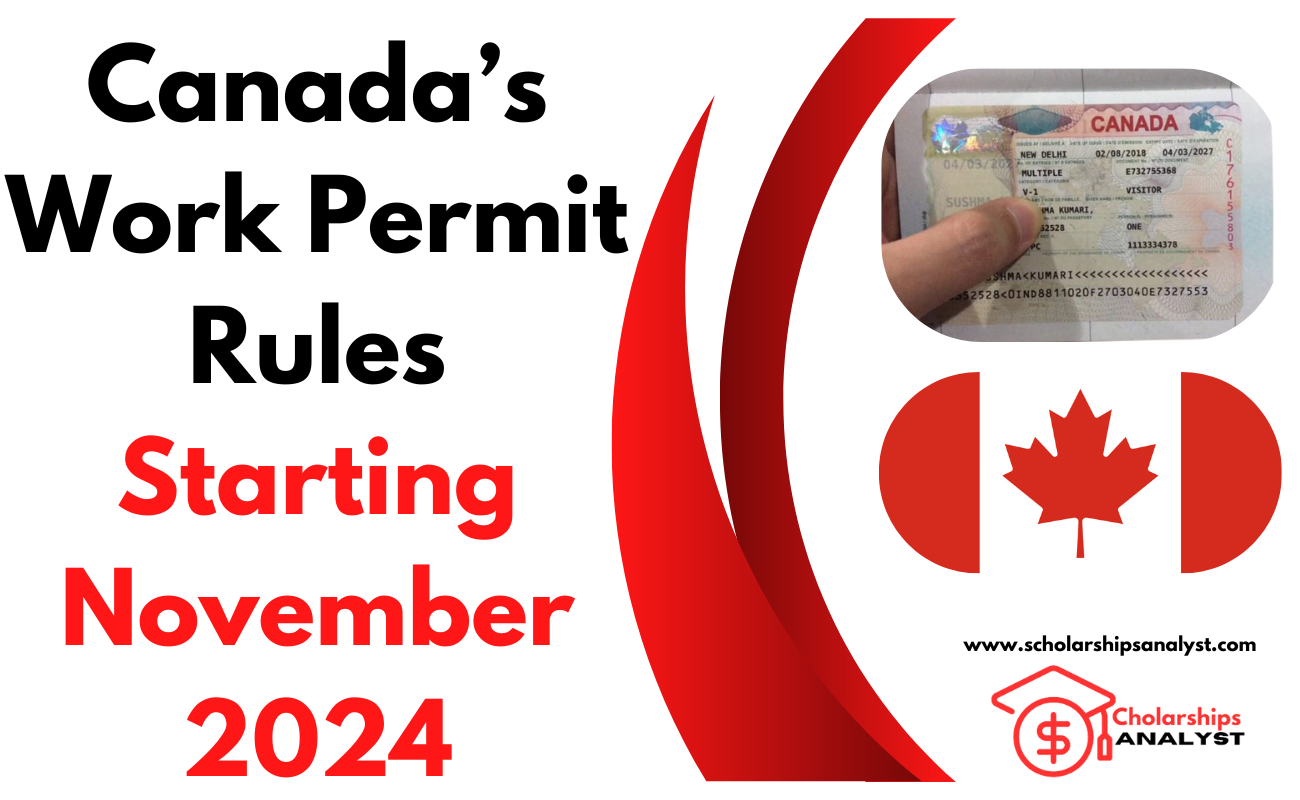Table of Contents
In November 2024, Canada will introduce major updates to its work permit system to address labor market needs, tighten eligibility for international students, and reduce dependence on temporary foreign workers. If you’re an international student, skilled worker, or temporary foreign worker in Canada, understanding these changes is essential.
Why Is Canada Updating Work Permit Rules?
Canada is a preferred destination for international students and foreign workers, offering a high standard of living, quality education, and ample job opportunities. However, with the growing number of temporary residents, concerns have risen about immigration sustainability. Immigration, Refugees, and Citizenship Canada (IRCC) aims to better align immigration practices with labor market needs through these new measures.
These rule changes support essential fields like healthcare, technology, and skilled trades while reducing reliance on low-wage foreign workers, thus promoting employment opportunities for Canadian residents.
Key Changes to Canada’s Work Permit System
1. Stricter Requirements for Post-Graduation Work Permit (PGWP)
The Post-Graduation Work Permit (PGWP) is a primary pathway for international students to gain Canadian work experience. New regulations, however, make obtaining a PGWP more challenging.
Language Proficiency:
Starting November 2024, PGWP applicants must meet higher language proficiency standards, achieving a Canadian Language Benchmark (CLB) level of 7 in English or Niveau de compétence linguistique canadien (NCLC) level 7 in French. This change ensures that graduates are prepared to enter Canada’s labor market and communicate effectively.
Field of Study:
PGWP eligibility will be restricted to students graduating from programs in high-demand sectors, such as healthcare, STEM, and skilled trades, aligning with Canada’s focus on critical labor shortages.
Example:
If you’re studying engineering or nursing, this change is likely to work in your favor. However, those in fields with less demand, like liberal arts, may find it more difficult to secure a PGWP.
2. Limitations on Spousal Open Work Permits (SOWP)
Previously, Spousal Open Work Permits (SOWP) allowed spouses of foreign workers in any sector to work in Canada. Under the new rules:
New Restrictions:
From November 2024, only spouses of foreign workers in sectors with significant labor shortages—such as healthcare, construction, and technology—will be eligible for SOWPs. This aims to reduce the issuance of approximately 100,000 spousal work permits over the next three years.
Example:
If your spouse is employed in healthcare or construction, they should still qualify for a SOWP. However, those in lower-demand sectors may no longer be eligible.
3. Adjustments to the Temporary Foreign Worker Program (TFWP)
The Temporary Foreign Worker Program (TFWP) allows employers to hire foreign workers when Canadian workers are unavailable. New regulations will impose tighter restrictions, especially for low-wage roles.
Cap on Low-Wage Workers:
Employers will be restricted to hiring foreign workers for no more than 10% of their workforce in low-wage positions. This cap encourages companies to prioritize hiring Canadian residents or permanent workers.
Shortened Permit Duration:
The maximum duration for work permits in low-wage roles will be reduced from two years to one year, requiring more frequent renewals and promoting long-term Canadian employment.
Example:
If you work in a low-wage position such as agriculture, you will need to renew your work permit annually. Employers must also adjust to the 10% cap for hiring foreign workers in these roles.
Preparing for Canada’s New Work Permit Rules
For International Students
Enroll in High-Demand Programs:
Consider choosing a program that aligns with Canada’s labor needs, such as healthcare, STEM, or skilled trades. This will improve your chances of obtaining a PGWP and long-term employment.
Enhance Language Proficiency:
Prepare for the stricter language requirements by improving your English (CLB 7) or French (NCLC 7) skills through language courses or certifications.
For Temporary Foreign Workers
Anticipate Permit Duration Changes:
If you work in a low-wage sector, plan ahead for shorter permit durations. Consider permanent employment opportunities in sectors with fewer restrictions.
Seek Employment in High-Demand Sectors:
Transitioning to sectors like healthcare or construction may provide more stable work options under the new regulations.
For Employers
Adjust Workforce Strategies:
With the new cap on low-wage foreign workers, employers should focus on recruiting Canadian residents or permanent workers. Employers in sectors like agriculture or construction may qualify for exemptions.
Stay Updated on Exemptions:
If your industry qualifies for certain exemptions, ensure you fully understand how these work to continue hiring temporary foreign workers when necessary.
Conclusion
Canada’s upcoming changes to work permit regulations, effective November 2024, reflect a commitment to sustaining a balanced immigration system that addresses critical workforce needs. Whether you are a student, a temporary foreign worker, or an employer, being informed and adapting to these new rules will help you navigate Canada’s updated immigration landscape.
FAQs on Canada’s Work Permit Changes Coming in November 2024
1. What are the new language proficiency requirements for the Post-Graduation Work Permit (PGWP)?
Starting in November 2024, PGWP applicants must meet a Canadian Language Benchmark (CLB) level of 7 in English or Niveau de compétence linguistique canadien (NCLC) level 7 in French. This aims to ensure that graduates are fully prepared to participate in the Canadian workforce.
2. Will all fields of study be eligible for the PGWP under the new rules?
No, eligibility for the PGWP will be limited to graduates from high-demand fields, including healthcare, science, technology, engineering, mathematics (STEM), and skilled trades. This change aligns with Canada’s goal to address labor shortages in critical sectors.
3. How will the new changes affect spouses of foreign workers in Canada?
Under the revised rules, only spouses of foreign workers employed in sectors facing significant labor shortages—such as healthcare, construction, and technology—will qualify for Spousal Open Work Permits (SOWP). This measure is expected to decrease the number of spousal work permits issued by approximately 100,000 over three years.
4. What restrictions are being placed on the Temporary Foreign Worker Program (TFWP)?
The new rules set a cap on low-wage foreign workers, limiting employers to hire only up to 10% of their workforce in low-wage roles. Additionally, the maximum duration of work permits for low-wage workers will be reduced from two years to one year, requiring more frequent renewals.
5. Why is Canada making these changes to its work permit system?
The changes aim to align Canada’s immigration practices with labor market needs by ensuring that critical sectors like healthcare, technology, and skilled trades have a steady supply of skilled workers. Additionally, the updates are designed to reduce dependency on low-wage foreign workers and encourage job opportunities for Canadian residents.
6. How can international students improve their chances of securing a PGWP under the new system?
International students should consider enrolling in high-demand fields such as healthcare, STEM, or skilled trades. Additionally, meeting the language proficiency requirements (CLB 7 in English or NCLC 7 in French) will be essential for PGWP eligibility.
7. What should low-wage temporary foreign workers be aware of with the upcoming changes?
Low-wage workers should plan for shorter work permit durations and consider pursuing permanent employment in sectors with fewer restrictions. Workers in low-wage roles will now be required to renew their work permits annually under most circumstances.
8. Are there any exemptions for certain industries under the new low-wage worker cap?
Yes, specific industries, including agriculture and construction, may have exemptions from the low-wage worker cap. Employers in these sectors should stay updated on the exemption criteria to continue hiring temporary foreign workers as needed.
9. How will these changes impact employers in Canada?
Employers will need to reassess their hiring strategies, especially if they rely on low-wage foreign workers, due to the new 10% cap and shortened permit durations. Businesses in exempt sectors should familiarize themselves with exemption details to ensure compliance.
10. How can foreign workers or students prepare for the upcoming work permit changes?
Individuals planning to work or study in Canada after November 2024 should proactively develop their qualifications. International students should focus on programs aligned with labor market needs, while temporary workers might explore job opportunities in high-demand sectors to improve their eligibility under the new rules.
11. How will these changes impact Canada’s labor market?
By encouraging skilled workers in critical fields and reducing reliance on temporary low-wage workers, these changes are expected to better support Canada’s economy. The updated rules are designed to help address labor shortages in high-demand sectors while protecting job opportunities for Canadian residents.




Leave a Comment